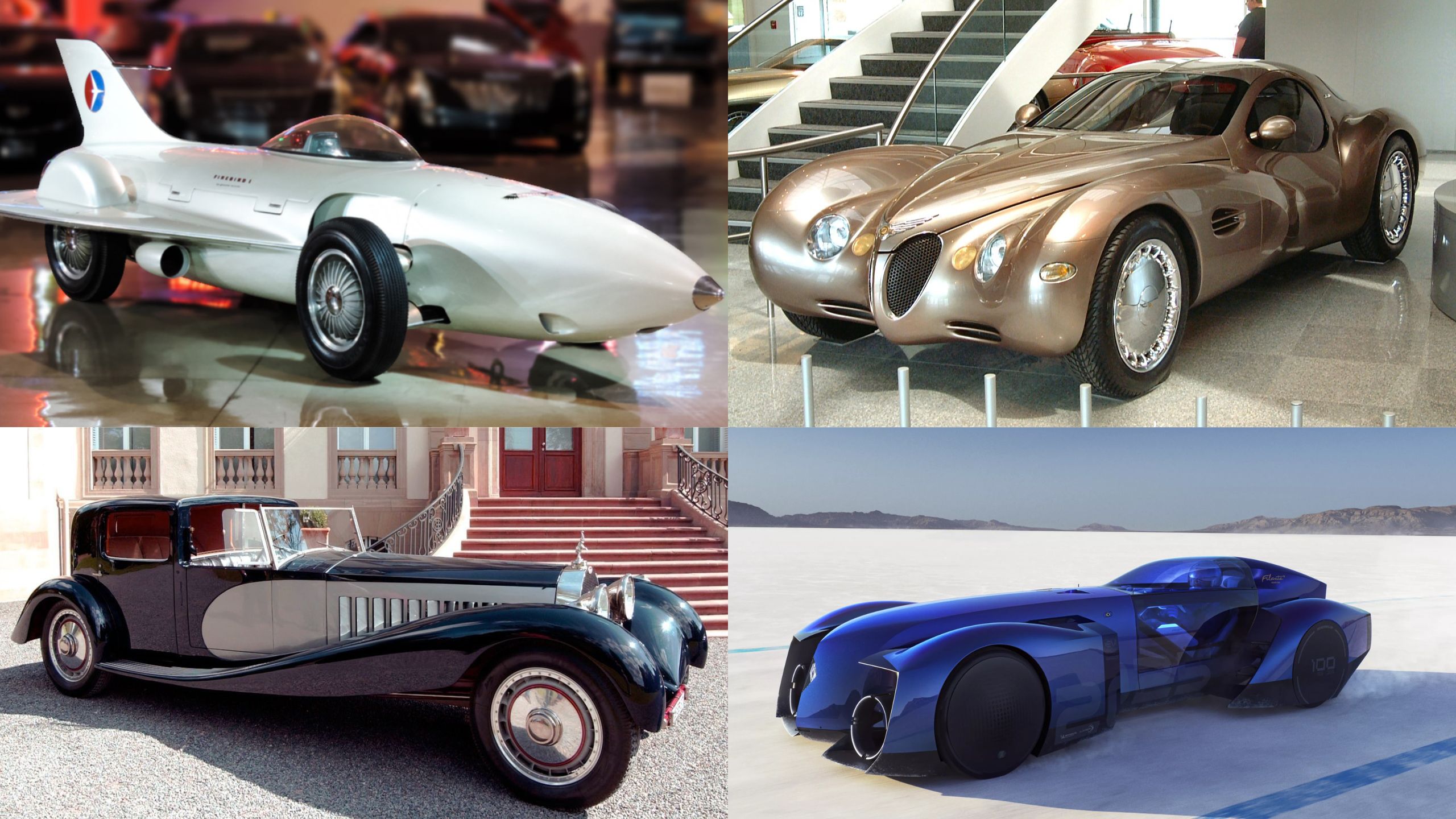Concept cars have always captured the imagination of car enthusiasts and the general public alike. These vehicles are often seen as a look into the future of automotive design and technology, showcasing innovative ideas and pushing the boundaries of what’s possible.
Concept cars are typically revealed at major auto shows, where manufacturers display their vision for the future and test the waters for potential new models. While many concept cars never make it to production, they play a crucial role in influencing the design and technology of future vehicles.
Over the years, we have seen a wide variety of concept cars, each with its own unique features and design elements. Some concept cars focus on cutting-edge technology, such as advanced driver-assistance systems, autonomous driving capabilities, and electric powertrains.
Others emphasize radical design, with futuristic shapes, unconventional materials, and bold color schemes. There are also concept cars that explore new types of mobility, such as flying cars, amphibious vehicles, and modular transportation systems.
In this article, we will explore the top 10 most unique concept cars ever created. These vehicles have left a lasting impression on the automotive industry and continue to inspire designers and engineers to think outside the box.
From the iconic GM Firebird II to the futuristic Mercedes-Benz F 015, these concept cars represent the pinnacle of automotive innovation and creativity. Whether you’re a car enthusiast or simply curious about the future of transportation, these unique concept cars are sure to fascinate your imagination.
1. Buick Y-Job (1938)
The Buick Y-Job revealed in 1938, is widely regarded as the world’s first concept car. Designed by Harley Earl, the head of General Motors Art and Color Section, the Y-Job set the standard for future concept cars by showcasing advanced styling and technological innovations that would influence automotive design for years to come.
The exterior design of the Buick Y-Job was groundbreaking for its time, featuring sleek and aerodynamic lines, a long hood, and a low, wide stance. The car’s distinctive front grille, hidden headlights, and integrated bumpers gave it a futuristic appearance that set it apart from other vehicles of the era
The Y-Job’s design was inspired by aircraft and streamlined modern architecture, resulting in a look that was both elegant and ahead of its time. Inside, the Y-Job offered a luxurious and spacious cabin with seating for four passengers.
The interior was adorned with high-quality materials, including leather upholstery and chrome accents, creating a premium atmosphere.
The car was equipped with advanced features such as power windows, a power-operated convertible top, and a retractable radio antenna, which were all considered cutting-edge technologies at the time.
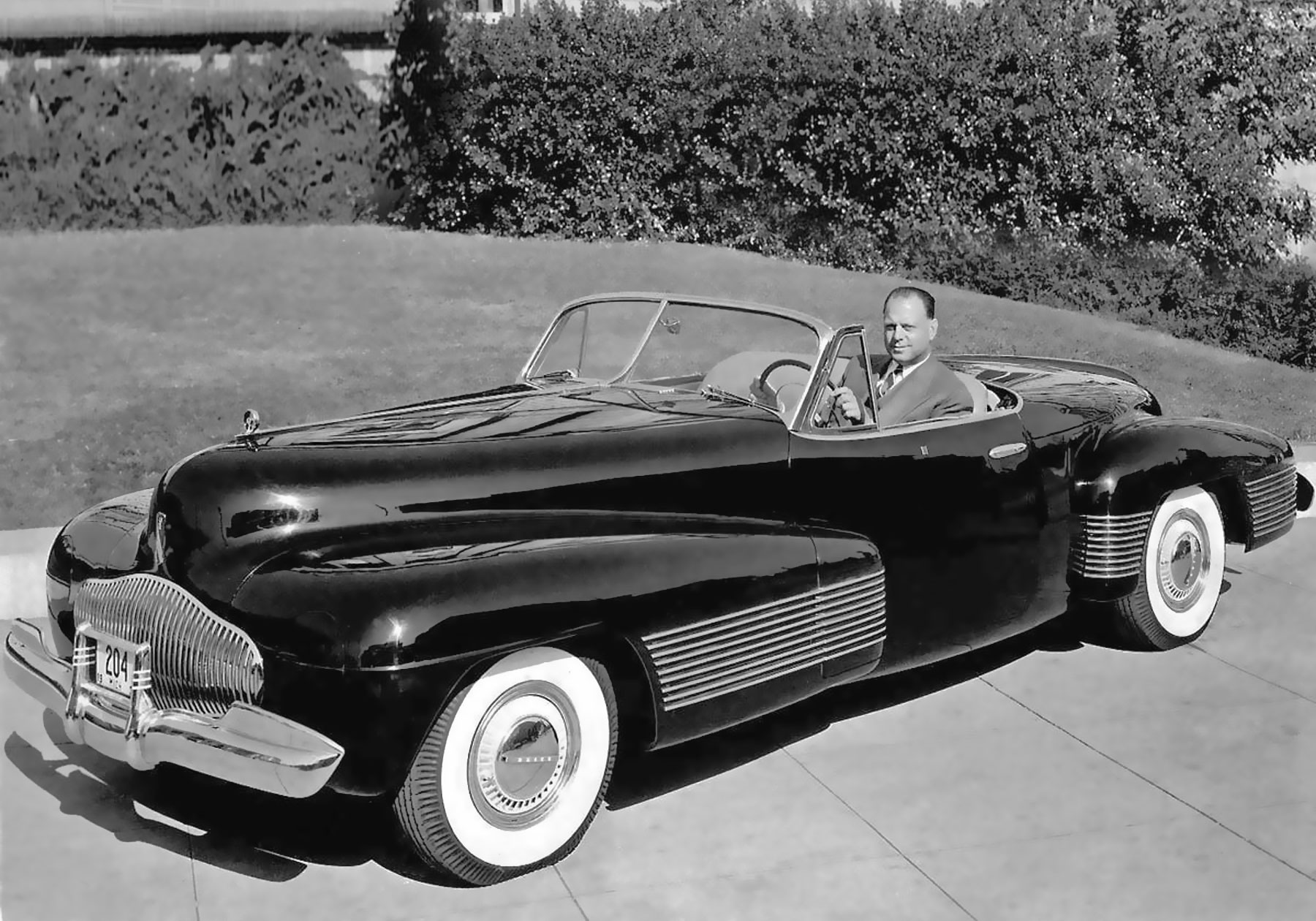
Under the hood, the Buick Y-Job was powered by a 5.3-liter straight-eight engine, delivering smooth and powerful performance. The car was built on a Buick Series 60 chassis, which provided a comfortable and stable ride.
While the Y-Job was never intended for production, it served as a rolling laboratory for testing new ideas and technologies that would later be incorporated into Buick’s production models.
The Buick Y-Job had a significant impact on the automotive industry, influencing the design and development of future concept cars.
Its innovative styling and advanced features set a new standard for what concept cars could achieve, and many of its design elements were later adopted by production vehicles. The Y-Job remains an iconic symbol of automotive innovation and a testament to Harley Earl’s visionary design.
2. Chrysler Turbine Car (1963)
The Chrysler Turbine Car, introduced in 1963, was an experimental vehicle that showcased the potential of turbine engine technology for automotive applications.
Developed by Chrysler’s Engineering Division, the Turbine Car was part of a larger research program aimed at exploring alternative powertrains that could offer greater efficiency and performance compared to traditional internal combustion engines.
The exterior design of the Chrysler Turbine Car was sleek and futuristic, featuring a low-slung profile, a distinctive front grille, and tail fins reminiscent of jet aircraft. The car’s body was constructed from steel and aluminum, giving it a lightweight yet sturdy structure.
The Turbine Car’s unique copper-colored paint, known as “Turbine Bronze,” further highlighted its advanced technology and modern design. Inside, the Turbine Car offered a spacious and luxurious cabin with seating for four passengers.
The interior was designed with comfort and convenience in mind, featuring high-quality materials, plush seats, and advanced instrumentation. The car was equipped with power windows, air conditioning, and a push-button transmission, making it one of the most technologically advanced vehicles of its time.
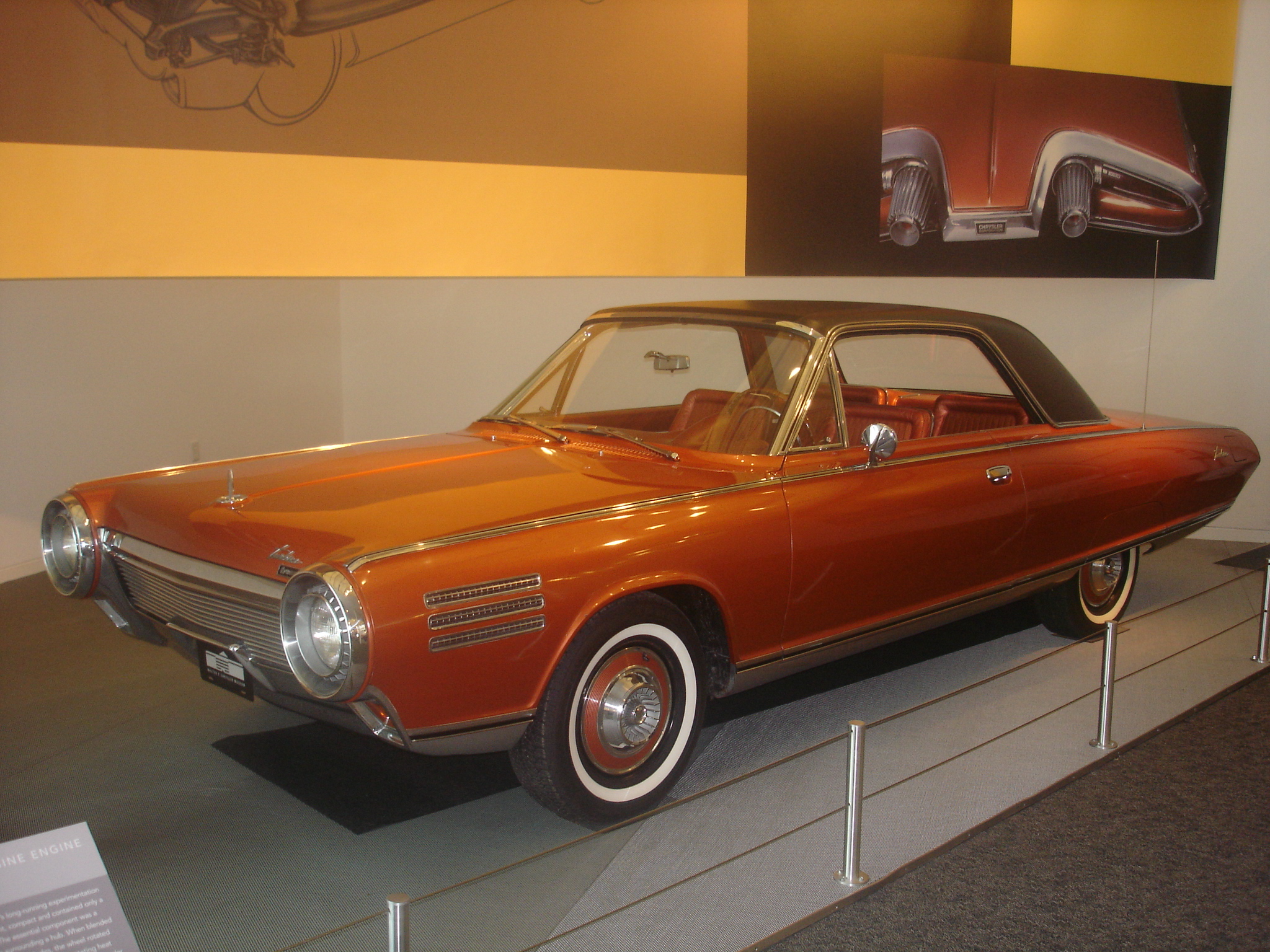
At the heart of the Chrysler Turbine Car was its revolutionary turbine engine. The car was powered by a gas turbine engine that operated on the principle of a jet engine, using a high-speed turbine to generate power.
The engine was capable of running on a variety of fuels, including gasoline, diesel, and even vegetable oil, making it highly versatile.
The turbine engine offered several advantages over traditional internal combustion engines, including smoother operation, fewer moving parts, and lower maintenance requirements.
Despite its advanced technology, the Chrysler Turbine Car faced several challenges that prevented it from reaching mass production. The high cost of the turbine engine, along with issues related to fuel consumption and emissions, ultimately led to the project’s discontinuation.
However, the Turbine Car’s innovative design and technology left a lasting legacy on the automotive industry, inspiring further research and development in alternative powertrains.
The Chrysler Turbine Car was a groundbreaking concept that showcased the potential of turbine engine technology for automotive use.
Its sleek design, luxurious interior, and revolutionary powertrain made it a unique and influential vehicle that continues to be celebrated as a symbol of automotive innovation.
3. Porsche 695 (1961)
The Porsche 695, also known as the Porsche 356B Carrera 2 GS/GT, was a unique concept car developed in the early 1960s as a high-performance variant of the iconic Porsche 356.
The 695 was designed to showcase Porsche’s engineering prowess and to compete in motorsports events, combining advanced technology with the brand’s signature design elements.
The exterior design of the Porsche 695 was based on the Porsche 356B, featuring a sleek and aerodynamic shape, a distinctive front grille, and rounded fenders. The car’s body was constructed from lightweight materials, including aluminum and fiberglass, to enhance performance and reduce weight.
The 695’s design was both elegant and functional, with a focus on improving aerodynamics and handling. Inside, the Porsche 695 offered a minimalist and driver-focused cabin with seating for two passengers.
The interior was designed with performance in mind, featuring lightweight bucket seats, a simple dashboard layout, and essential instrumentation. The car’s steering wheel and controls were positioned for optimal driver engagement, ensuring a responsive and enjoyable driving experience.
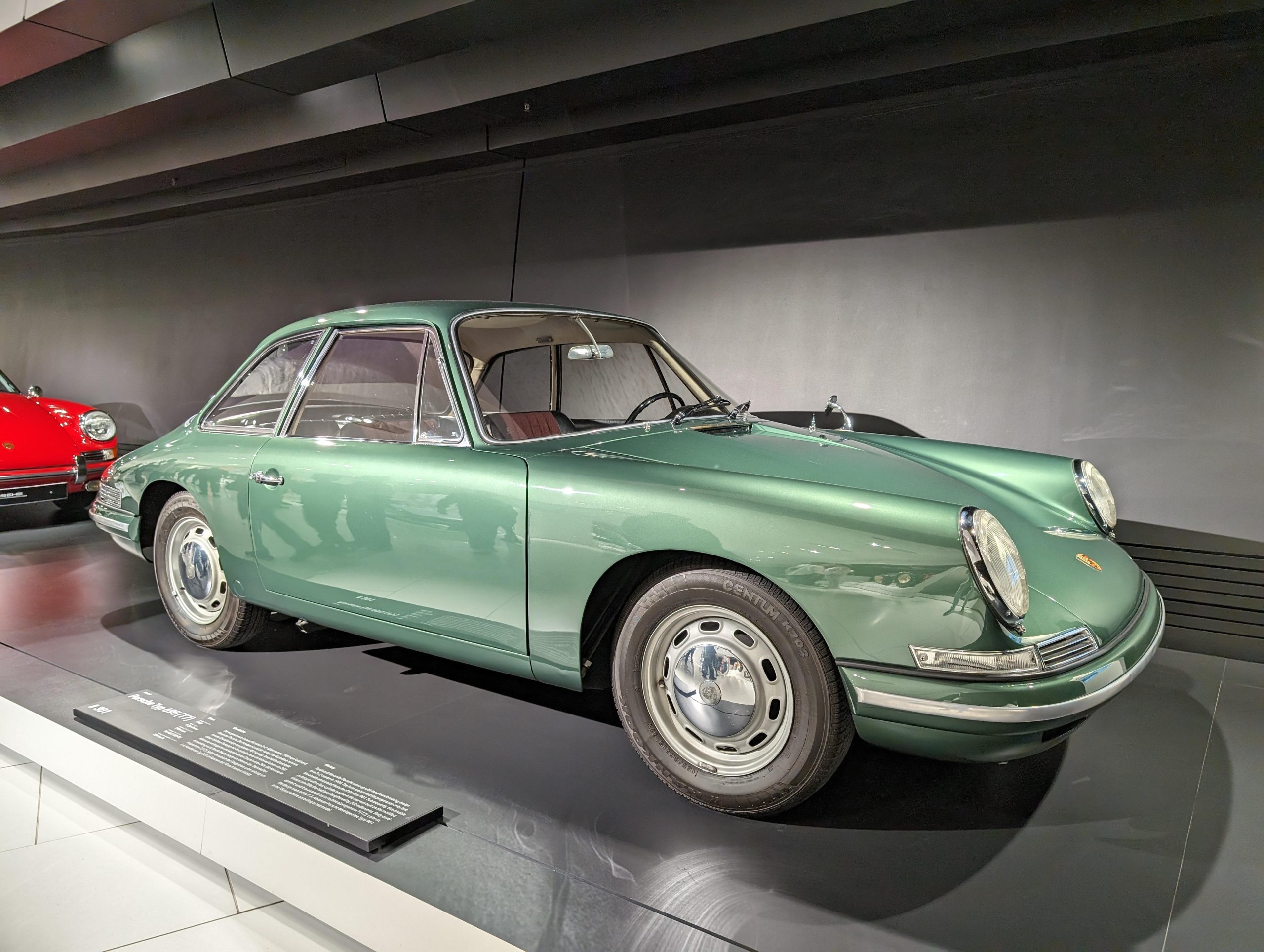
Under the hood, the Porsche 695 was powered by a high-performance 2.0-liter four-cylinder engine, known as the Carrera 2 engine. This engine featured dual overhead camshafts, dual carburetors, and a high compression ratio, delivering impressive power and acceleration.
The 695 was equipped with a five-speed manual transmission, allowing for precise gear changes and enhanced performance on the track. The Porsche 695 also featured advanced suspension and braking systems, designed to provide exceptional handling and stability.
The car’s independent suspension, along with its lightweight construction, allowed it to corner with precision and agility. The 695’s braking system included large disc brakes, ensuring reliable stopping power even under demanding driving conditions.
While the Porsche 695 was never intended for mass production, it served as a testbed for new technologies and engineering solutions that would later be incorporated into Porsche’s production models.
The car’s innovative design and performance capabilities left a lasting impact on the brand, influencing the development of future high-performance models.
The Porsche 695 was a unique concept car that showcased Porsche’s engineering excellence and commitment to high-performance driving. Its sleek design, advanced technology, and impressive performance made it a standout vehicle that continues to be celebrated as a symbol of Porsche’s legacy in motorsports.
4. Chrysler Atlantic (1995)
The Chrysler Atlantic, revealed in 1995, was a luxury concept car that paid homage to the classic design of 1930s Art Deco automobiles. Designed by Bob Hubbach and Tom Gale, the Atlantic combined vintage styling with modern technology, creating a unique and elegant vehicle that captured the spirit of a bygone era while showcasing Chrysler’s vision for the future.
The exterior design of the Chrysler Atlantic was heavily influenced by the 1937 Bugatti Type 57S Atlantic, featuring flowing lines, a long hood, and a distinctive split windshield.
The car’s body was constructed from lightweight materials, including aluminum and composite panels, to enhance performance and reduce weight.
The Atlantic’s design was both nostalgic and futuristic, with a focus on capturing the elegance and sophistication of pre-war luxury cars. Inside, the Atlantic offered a lavish and opulent cabin with seating for four passengers.
The interior was adorned with high-quality materials, including leather upholstery, wood trim, and chrome accents, creating a sense of luxury and refinement.
The car was equipped with advanced technology, including a state-of-the-art sound system, climate control, and digital instrumentation. The Atlantic’s interior design was a blend of classic and contemporary elements, creating a unique and inviting environment for passengers.
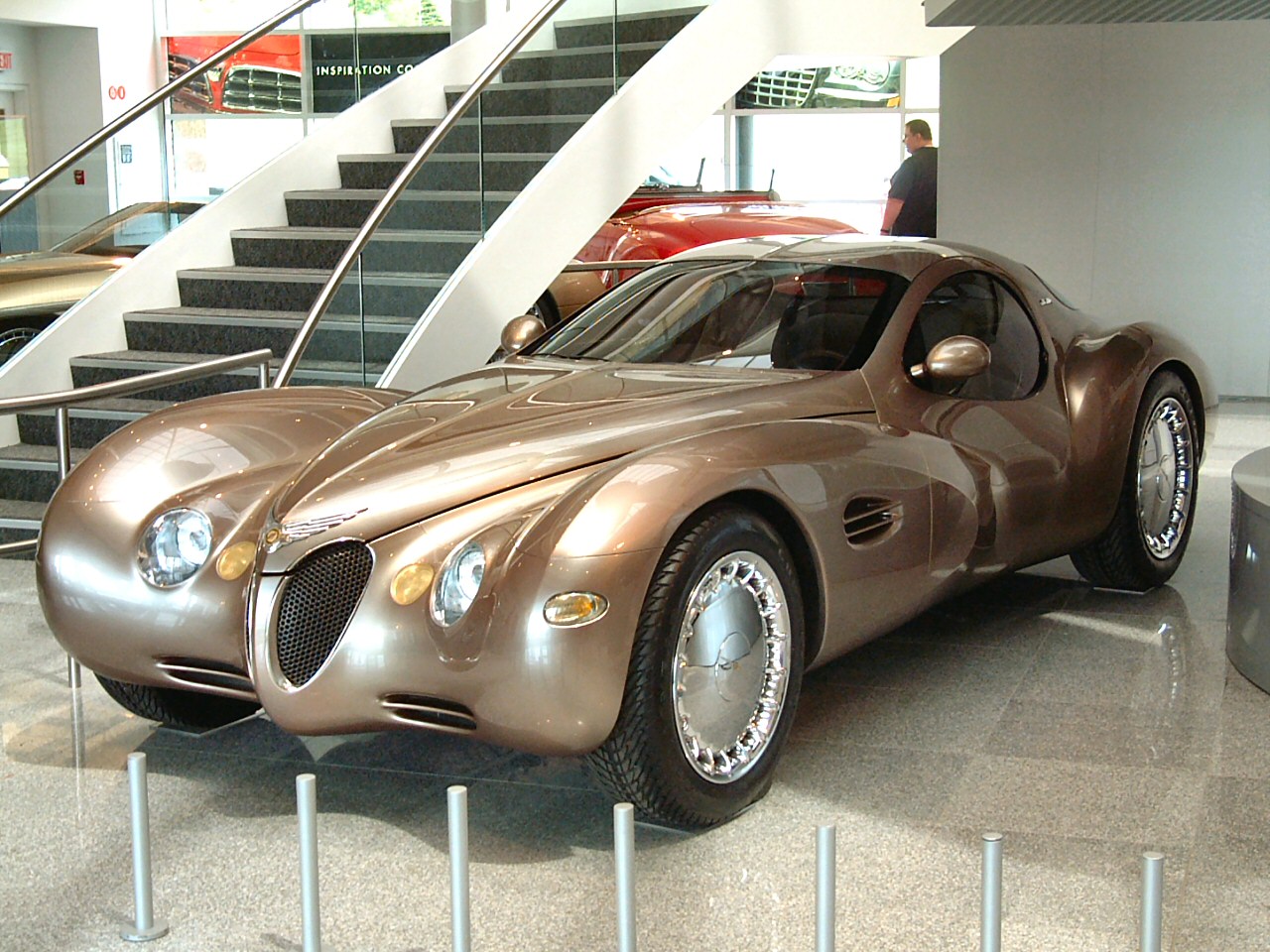
Under the hood, the Chrysler Atlantic was powered by a custom-built 4.0-liter inline-eight engine, developed specifically for the concept car.
The engine featured dual overhead camshafts, four valves per cylinder, and electronic fuel injection, delivering smooth and responsive performance. The car was equipped with a four-speed automatic transmission, ensuring a comfortable and enjoyable driving experience.
The Chrysler Atlantic also featured advanced suspension and braking systems, designed to provide a smooth and stable ride.
The car’s independent suspension, along with its lightweight construction, allowed it to handle with precision and agility. The Atlantic’s braking system included large disc brakes, ensuring reliable stopping power even under demanding driving conditions.
The Chrysler Atlantic was a luxury concept car that combined vintage styling with modern technology, creating a unique and elegant vehicle that captured the spirit of classic automobiles.
Its distinctive design, opulent interior, and advanced features made it a standout vehicle that continues to be celebrated as a symbol of automotive innovation and craftsmanship.
Also Read: Top 10 Convertibles That Make Every Drive Fun For You
5. Renault Filante Record 2025
The Renault Filante Record 2025 is a futuristic concept car that was revealed to showcase Renault’s vision for high-performance, sustainable mobility. The Filante, which means “shooting star” in French, is designed to break speed records while emphasizing advanced aerodynamics and cutting-edge technology.
The exterior design of the Renault Filante Record 2025 is sleek and aerodynamic, featuring a low-slung profile, sharp lines, and a distinctive front fascia.
The car’s body is constructed from lightweight materials, including carbon fiber and aluminum, to enhance performance and reduce weight. The Filante’s design is both futuristic and functional, with a focus on improving aerodynamics and reducing drag.
Inside, the Filante Record 2025 offers a minimalist and driver-focused cabin with seating for two passengers. The interior is designed with performance in mind, featuring lightweight racing seats, a digital instrument cluster, and essential controls and displays.
The car’s steering wheel is equipped with various buttons and switches to adjust performance settings and driving modes.
The Filante’s interior design is both modern and functional, providing a seamless connection between the driver and the vehicle. The Renault Filante Record 2025 is powered by a state-of-the-art electric powertrain, designed to deliver both high performance and environmental sustainability.
The vehicle’s electric motors generate an impressive amount of power, allowing the Filante to reach record-breaking speeds while maintaining zero emissions. The car is equipped with advanced battery technology, providing a substantial driving range and fast charging capabilities.
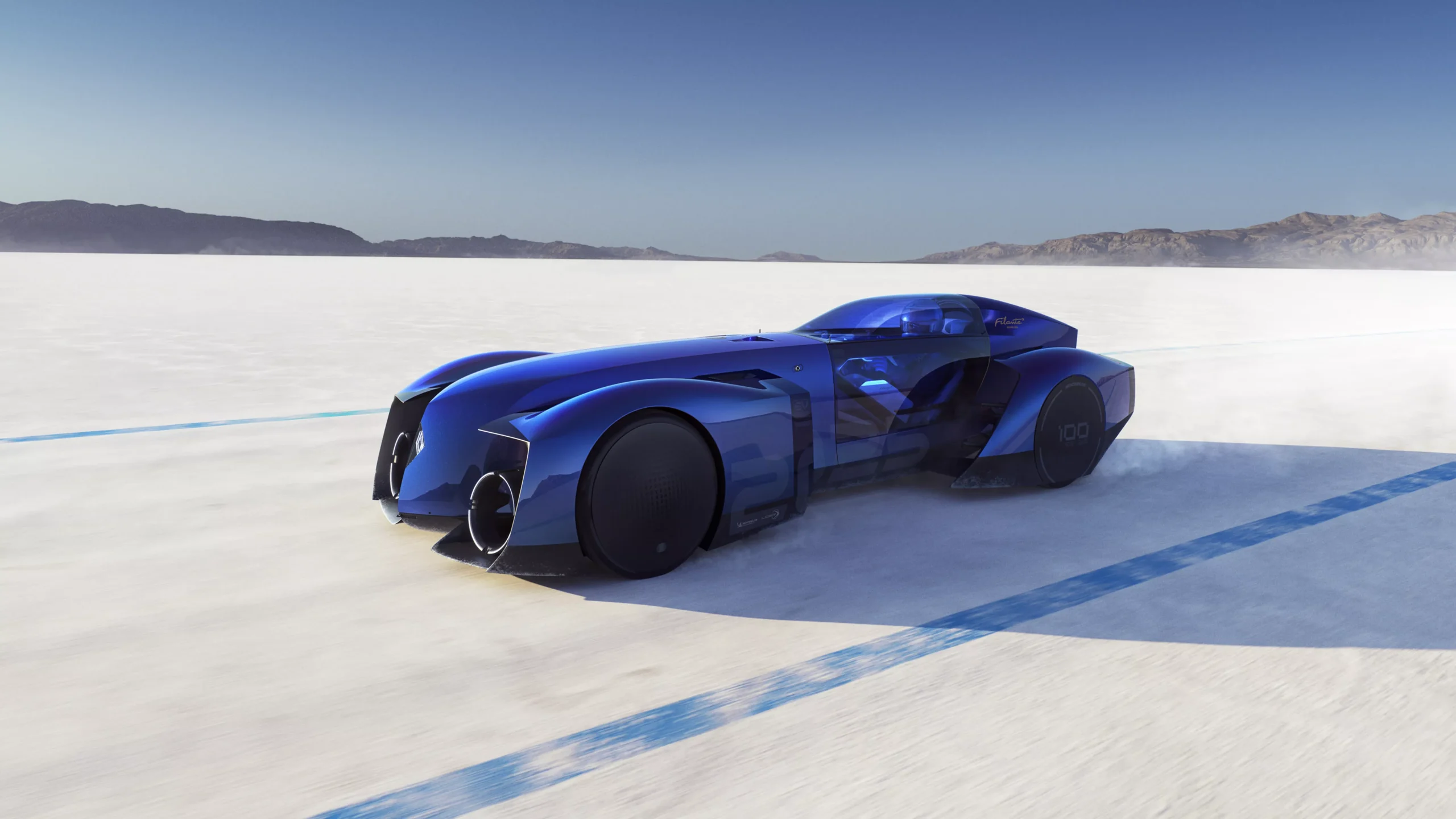
One of the key innovations of the Filante Record 2025 is its active aerodynamics system. The car features adjustable aerodynamic elements, such as an adaptive rear wing and active air vents, which optimize airflow and downforce based on driving conditions.
This system enhances stability and performance at high speeds, ensuring that the Filante remains planted on the road.
The Renault Filante Record 2025 also incorporates advanced driver-assistance systems to enhance safety and performance. These systems include adaptive cruise control, lane-keeping assist, and automatic emergency braking.
The car is equipped with a suite of sensors, cameras, and radar to monitor the vehicle’s surroundings and provide real-time feedback to the driver.
Additionally, the Filante features an advanced telemetry system, allowing engineers to collect and analyze performance data during high-speed runs.
The Renault Filante Record 2025 is a futuristic concept car that showcases Renault’s commitment to high-performance, sustainable mobility. Its sleek design, advanced technology, and record-breaking capabilities make it a standout vehicle that represents the future of automotive innovation.
6. Porsche 918 Spyder
The Porsche 918 Spyder, revealed in 2010, is a high-performance hybrid supercar that combines cutting-edge technology with Porsche’s legendary engineering prowess. As one of the most advanced and powerful sports cars ever created, the 918 Spyder showcases the potential of hybrid technology in the high-performance driving.
The exterior design of the Porsche 918 Spyder is both sleek and aggressive, featuring a low-slung profile, sharp lines, and a wide stance.
The car’s body is constructed from lightweight materials, including carbon fiber and aluminum, to enhance performance and reduce weight. The 918 Spyder’s design is both functional and aesthetically pleasing, with a focus on aerodynamics and stability at high speeds.
Inside, the 918 Spyder offers a luxurious and driver-focused cabin with seating for two passengers. The interior is adorned with high-quality materials, including leather upholstery, carbon fiber trim, and Alcantara accents, creating a premium atmosphere.
The car is equipped with advanced technology, including a digital instrument cluster, a touchscreen infotainment system, and various performance-oriented controls.

The Porsche 918 Spyder is powered by a hybrid powertrain that combines a 4.6-liter V8 engine with two electric motors. This setup delivers a total output of 887 horsepower, allowing the 918 Spyder to achieve breathtaking acceleration and top speeds. The car features all-wheel drive, with the electric motors providing additional power to the front wheels for enhanced traction and performance.
One of the key innovations of the 918 Spyder is its ability to operate in multiple driving modes, including all-electric, hybrid, and performance modes. In all-electric mode, the car can travel up to 18 miles on electric power alone, making it suitable for short trips and urban driving.
In hybrid mode, the car optimizes the use of both the V8 engine and electric motors for maximum efficiency. In performance mode, the 918 Spyder unleashes its full power, delivering exhilarating acceleration and handling.
The Porsche 918 Spyder also features advanced aerodynamics, including an adjustable rear wing, active air vents, and a rear diffuser.
These elements work together to optimize airflow and downforce, ensuring stability and performance at high speeds. The car is equipped with a sophisticated suspension system, providing precise handling and a comfortable ride.
The Porsche 918 Spyder is a high-performance hybrid supercar that exemplifies Porsche’s engineering excellence and commitment to innovation. Its sleek design, advanced technology, and impressive performance make it a standout vehicle in high-performance driving.
7. Bugatti Type 41 Royale
The Bugatti Type 41 Royale, also known simply as the Bugatti Royale, is one of the most iconic and luxurious automobiles ever created.
Introduced in 1927, the Royale was designed by Ettore Bugatti as a grand luxury car for royalty and the ultra-wealthy. With its massive size, powerful engine, and opulent design, the Royale remains a symbol of automotive excellence and exclusivity.
The exterior design of the Bugatti Royale is characterized by its immense proportions and elegant lines.
The car’s long wheelbase, flowing fenders, and distinctive radiator grille create a commanding presence on the road. The Royale’s body was custom-built by renowned coachbuilders, resulting in a variety of unique and luxurious designs.
Each Royale was meticulously crafted to meet the specific desires of its owner, making every car a one-of-a-kind masterpiece.
The Bugatti Royale offered a lavish and spacious cabin with seating up to seven passengers. The interior was adorned with the finest materials, including leather upholstery, wood trim, and precious metals
The car was equipped with advanced features for its time, such as electric windows, a sophisticated heating system, and an opulent dashboard with intricate instrumentation. The Royale’s interior design was a testament to Bugatti’s commitment to craftsmanship and luxury.
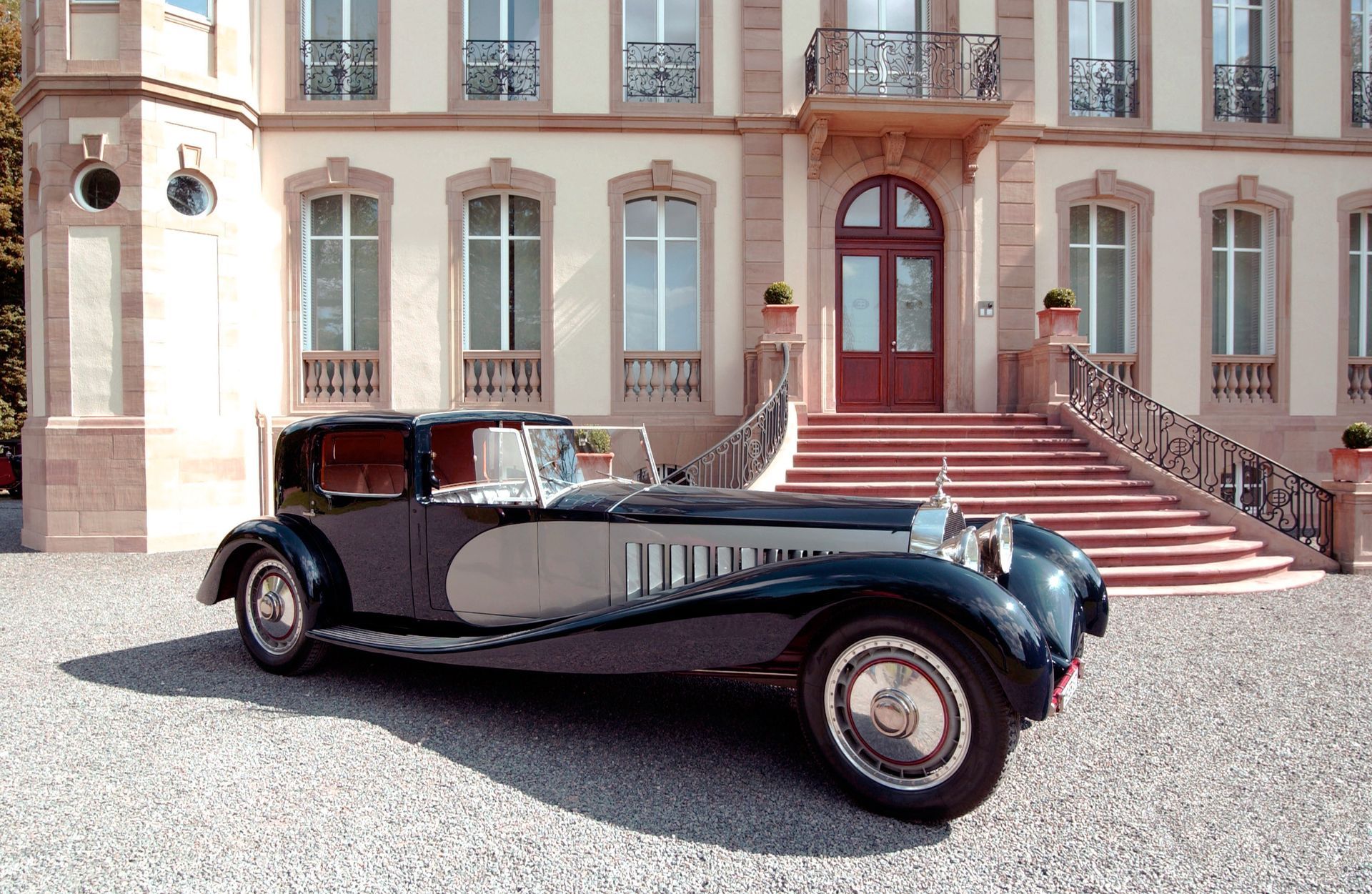
Under the hood, the Bugatti Royale was powered by a massive 12.7-liter straight-eight engine, capable of producing 300 horsepower. This engine was derived from an aircraft engine that Bugatti had originally designed for use in airplanes.
The Royale’s engine delivered smooth and effortless performance, allowing the car to reach impressive speeds despite its large size. The car was equipped with a three-speed manual transmission, providing a refined and powerful driving experience.
The Bugatti Royale also featured advanced suspension and braking systems, designed to provide a comfortable and stable ride.
The car’s independent front suspension and leaf-spring rear suspension allowed it to glide over rough roads with ease. The Royale’s braking system included large drum brakes, ensuring reliable stopping power even for a car of its size.
Only six Bugatti Royales were ever built, and they remain among the most sought-after and valuable automobiles. Each Royale is a unique piece of automotive history, representing the pinnacle of luxury and engineering excellence.
The Bugatti Royale’s enduring legacy continues to inspire automotive designers and enthusiasts, making it a timeless icon in classic cars.
8. Lamborghini Miura Concept
The Lamborghini Miura Concept revealed in 2006, was a modern reinterpretation of the iconic Lamborghini Miura, which was originally introduced in 1966.
Designed to celebrate the 40th anniversary of the original Miura, the concept car aimed to capture the spirit and design language of the classic supercar while incorporating modern technology and engineering.
The exterior design of the Lamborghini Miura Concept was heavily influenced by the original Miura, featuring a low-slung profile, sharp lines, and a distinctive front fascia.
The car’s body was constructed from lightweight materials, including carbon fiber and aluminum, to enhance performance and reduce weight.
The Miura Concept’s design paid homage to its predecessor with elements such as the clamshell hood, side air intakes, and iconic “eyelash” headlight surrounds. The Miura Concept offered a luxurious and driver-focused cabin with seating for two passengers.
The interior was adorned with high-quality materials, including leather upholstery, carbon fiber trim, and Alcantara accents, creating a premium atmosphere.
The car was equipped with advanced technology, including a digital instrument cluster, a touchscreen infotainment system, and various performance-oriented controls.
The Miura Concept’s interior design blended classic and modern elements, providing a seamless connection between the driver and the vehicle.
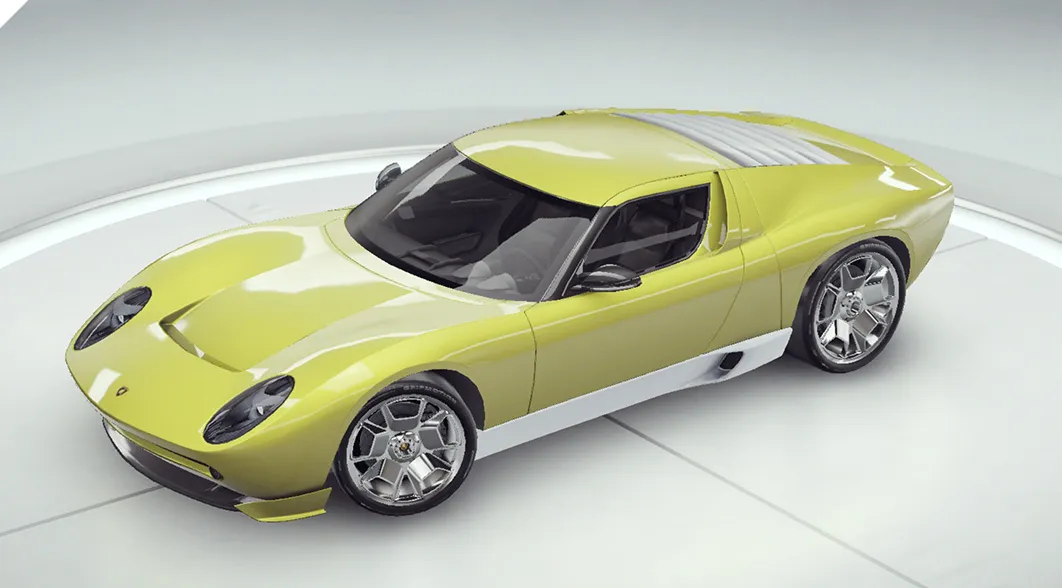
The Lamborghini Miura Concept was powered by a mid-mounted 6.2-liter V12 engine, delivering exceptional performance and acceleration. The engine was mated to a six-speed manual transmission, allowing for precise gear changes and an engaging driving experience. The car featured all-wheel drive, providing enhanced traction and stability in various driving conditions.
One of the key innovations of the Miura Concept was its advanced aerodynamics. The car featured an adjustable rear wing, active air vents, and a rear diffuser, all designed to optimize airflow and downforce. These elements worked together to ensure stability and performance at high speeds, making the Miura Concept a true supercar.
The Lamborghini Miura Concept was a modern reinterpretation of an iconic classic, combining timeless design with cutting-edge technology and engineering. Its sleek design, luxurious interior, and impressive performance made it a standout vehicle that celebrated Lamborghini’s rich heritage while showcasing the brand’s future direction.
9. General Motors Firebird I (1953)
The General Motors Firebird I, introduced in 1953, was the first in a series of experimental concept cars designed to showcase advanced automotive technology and futuristic design.
Inspired by jet aircraft, the Firebird I was created by Harley Earl and his team at GM’s Styling Division, pushing the boundaries of what a car could be and serving as a testbed for innovative ideas.
The exterior design of the GM Firebird I was heavily influenced by fighter jets, featuring a sleek, aerodynamic shape, a pointed nose, and large tail fins. The car’s body was constructed from lightweight fiberglass, giving it a futuristic appearance and reducing weight.
The Firebird I’s canopy-style roof opened upwards, similar to a jet cockpit, providing easy access to the interior. The car’s jet-inspired design made it one of the most striking and unique concept cars of its time.
Inside, the Firebird I offered a minimalist and driver-focused cockpit with seating for one. The interior was designed with performance in mind, featuring essential instrumentation and controls positioned for optimal driver engagement.
The car’s steering wheel was inspired by an aircraft yoke, adding to the aviation theme. The Firebird I’s interior design emphasized simplicity and functionality, ensuring a seamless connection between the driver and the vehicle.
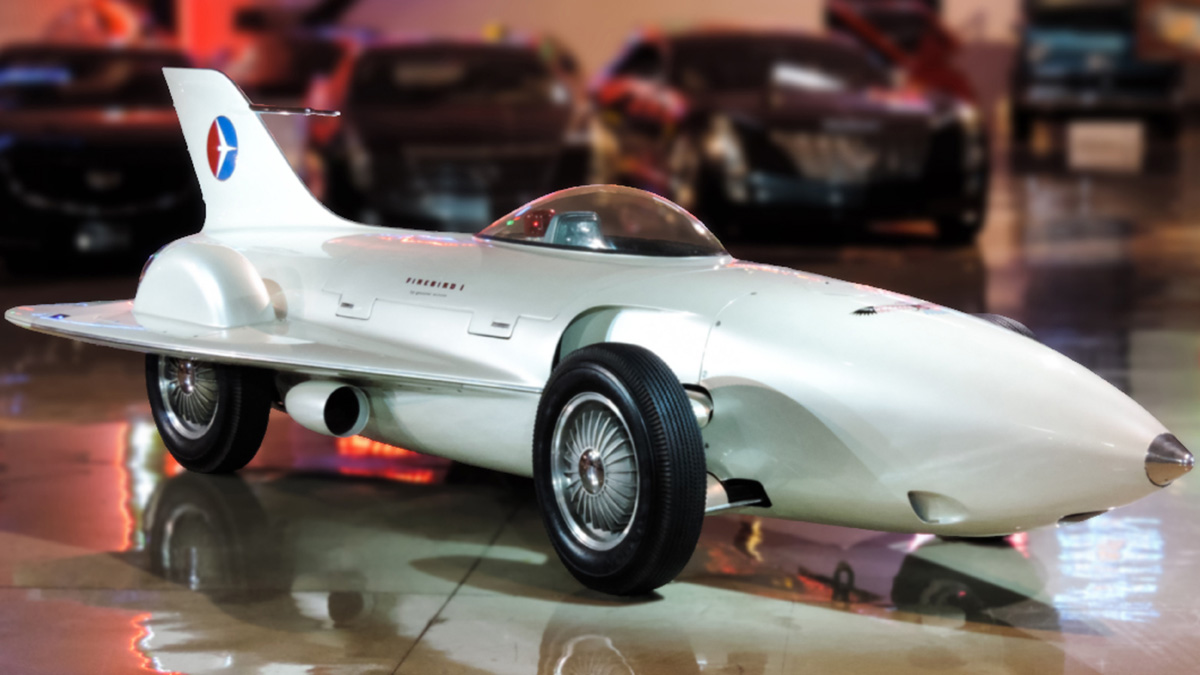
The GM Firebird I was powered by a gas turbine engine, a technology inspired by jet aircraft engines. The Whirlfire Turbo-Power engine produced 370 horsepower and operated at extremely high RPMs, providing the Firebird I with impressive performance.
The turbine engine was capable of running on various fuels, including gasoline and kerosene. The car featured a four-wheel independent suspension, ensuring a smooth and stable ride even at high speeds.
One of the key innovations of the Firebird I was its early exploration of advanced aerodynamics. The car’s design emphasized reducing drag and maximizing airflow, with elements like a pointed nose, a canopy roof, and large tail fins. These features not only gave the Firebird I its distinctive appearance but also improved its performance and stability.
Although the GM Firebird I was never intended for mass production, it served as a valuable testbed for new technologies and design concepts. The car’s influence can be seen in many modern vehicles, particularly in the development of gas turbine engines and aerodynamics. The Firebird I remains an iconic symbol of automotive innovation and a testament to Harley Earl’s visionary design.
10. Ford GT90 (1995)
The Ford GT90 revealed in 1995, is a high-performance concept car that represents Ford’s vision for the ultimate supercar.
The GT90 was designed to showcase advanced technology, cutting-edge design, and exceptional performance, drawing inspiration from the iconic Ford GT40 that dominated Le Mans in the 1960s.
The exterior design of the Ford GT90 is both aggressive and futuristic, featuring a low-slung profile, sharp lines, and a distinctive front fascia. The car’s body is constructed from lightweight materials, including carbon fiber and aluminum, to enhance performance and reduce weight.
The GT90’s design incorporates advanced aerodynamics, with elements like a pointed nose, large air intakes, and an adjustable rear wing to optimize airflow and downforce.
The GT90 offers a minimalist and driver-focused cabin with seating for two passengers. The interior is designed with performance in mind, featuring lightweight bucket seats, a digital instrument cluster, and essential controls and displays.
The car’s steering wheel is equipped with various buttons and switches to adjust performance settings and driving modes. The GT90’s interior design emphasizes simplicity and functionality, ensuring a seamless connection between the driver and the vehicle.
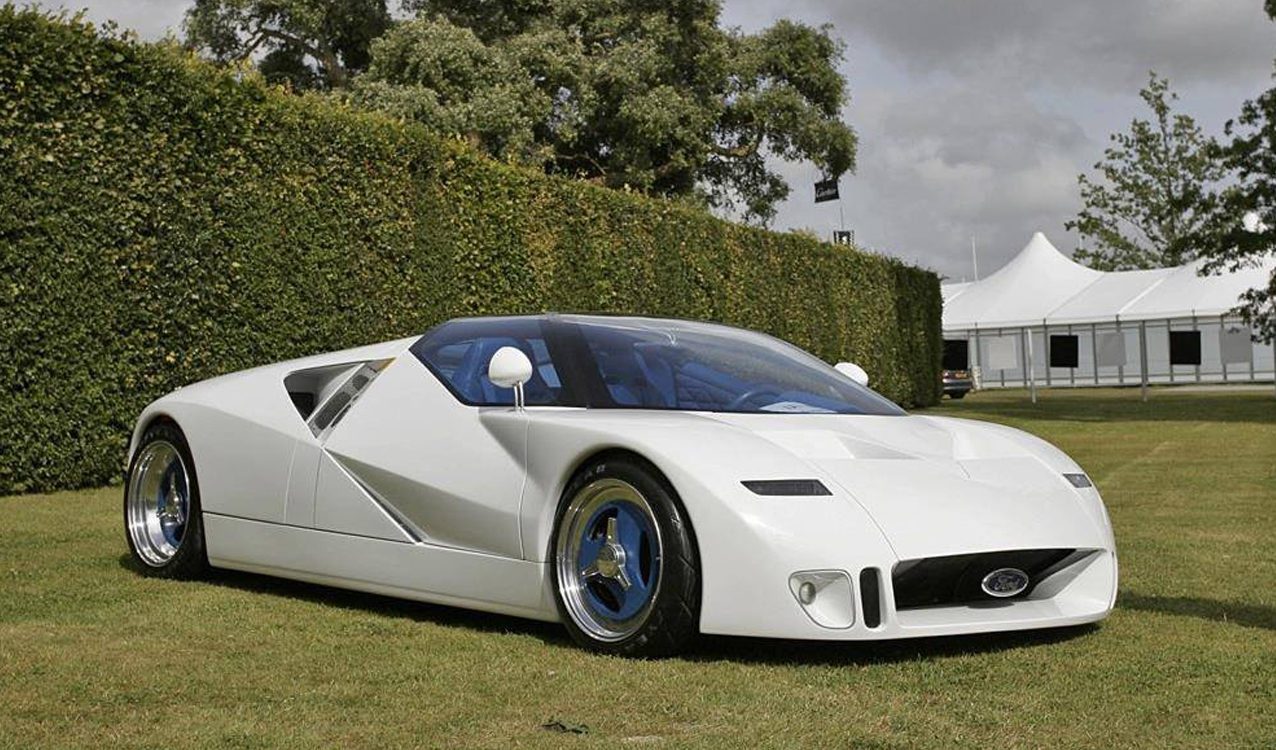
The Ford GT90 is powered by a quad-turbocharged 6.0-liter V12 engine, delivering an astonishing 720 horsepower. This powerful engine allows the GT90 to achieve breathtaking acceleration and top speeds, making it one of the fastest concept cars ever created.
The car is equipped with a six-speed manual transmission, providing precise gear changes and an engaging driving experience.
One of the key innovations of the GT90 is its advanced aerodynamics. The car features an adjustable rear wing, active air vents, and a rear diffuser, all designed to optimize airflow and downforce.
These elements work together to ensure stability and performance at high speeds, making the GT90 a true supercar. The Ford GT90 is a high-performance concept car that exemplifies Ford’s engineering excellence and commitment to innovation.
Its aggressive design, luxurious interior, and impressive performance make it a standout vehicle that continues to be celebrated as a symbol of automotive excellence.
Also Read: 10 Cars with the Best Gas Mileage That Save You Money

